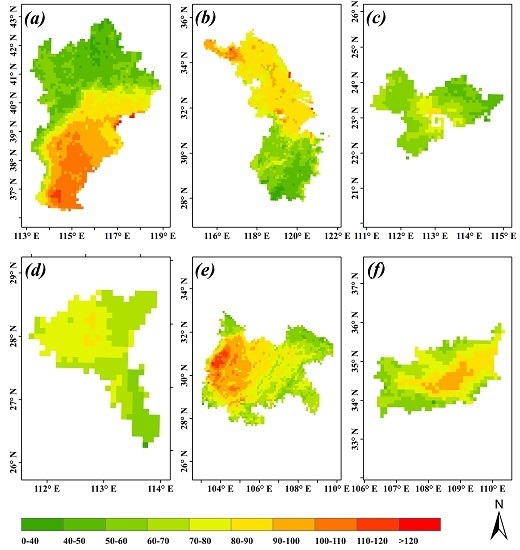Scale- and Region-Dependence in Landscape-PM2.5 Correlation: Implications for Urban Planning
Abstract
1. Introduction
2. Materials and Methods
2.1. Study Area
2.2. Data and Pre-Processing
2.2.1. Land Use
2.2.2. In Situ PM2.5 Concentration
2.2.3. Satellite-Retrieved AOD Data
2.3. Methodologies
2.3.1. Estimation of Spatial PM2.5 Concentration
2.3.2. Landscape Pattern Analysis
2.3.3. Correlation between PM2.5 Concentration and Landscape
3. Results
3.1. Land Use and Landscape Patterns
3.2. Variation of PM2.5 Concentration
3.3. Scale-Dependence of Landscape-PM2.5 Correlation over Different Regions
3.3.1. In Situ Scale
3.3.2. Regional Scale
3.3.3. Comparison of the Correlations at In Situ and Regional Scales
4. Discussion
5. Conclusions
Acknowledgments
Author Contributions
Conflicts of Interest
References
- Fann, N.; Lamson, A.D.; Anenberg, S.C.; Wesson, K.; Risley, D.; Hubbell, B.J. Estimating the National Public Health Burden Associated with Exposure to Ambient PM2.5 and Ozone. Risk Anal. 2012, 32, 81–95. [Google Scholar] [CrossRef] [PubMed]
- Boldo, E.; Medina, S.; LeTertre, A.; Hurley, F.; Mücke, H.G.; Ballester, F.; Aguilera, I.; Eilstein, D. Apheis: Health Impact Assessment of Long-Term Exposure to PM2.5 in 23 European Cities. Eur. J. Epidemiol. 2006, 21, 449–458. [Google Scholar] [CrossRef] [PubMed]
- Franklin, M.; Zeka, A.; Schwartz, J. Association between PM2.5 and All-Cause and Specific-Cause Mortality in 27 Us Communities. J. Exp. Sci. Environ. Epidemiol. 2007, 17, 279–287. [Google Scholar] [CrossRef] [PubMed]
- Zhang, Q.; Jiang, X.; Tong, D.; Davis, S.J.; Zhao, H.; Geng, G.; Feng, T.; Zheng, B.; Lu, Z.; Streets, D.G.; et al. Transboundary Health Impacts of Transported Global Air Pollution and International Trade. Nature 2017, 543, 705–709. [Google Scholar] [CrossRef] [PubMed]
- Huang, R.J.; Zhang, Y.; Bozzetti, C.; Ho, K.F.; Cao, J.J.; Han, Y.; Daellenbach, K.R.; Slowik, J.G.; Platt, S.M.; Canonaco, F.; et al. High Secondary Aerosol Contribution to Particulate Pollution During Haze Events in China. Nature 2014, 514, 218–222. [Google Scholar] [CrossRef] [PubMed]
- Zhang, Y.L.; Fang, C. Fine Particulate Matter (PM2.5) in China at a City Level. Sci. Rep. 2015, 5, 14884. [Google Scholar] [CrossRef] [PubMed]
- Wang, J.; Jia, X.; Rohit, M.; Jonathan, E.P.; Wang, S.; Christian, H.; Gan, C.M.; Wong, D.C.; Hao, J. Historical Trends in PM2.5-Related Premature Mortality During 1990–2010 across the Northern Hemisphere. Environ. Health Perspect. 2017, 125, 400–408. [Google Scholar] [CrossRef] [PubMed]
- Liu, Y.; Li, Y.; Chen, C. Pollution: Build on Success in China. Nature 2015, 517, 145. [Google Scholar] [CrossRef] [PubMed]
- Vayenas, D.V.; Takahama, S.; Davidson, C.I.; Pandis, S.N. Simulation of the Thermodynamics and Removal Processes in the Sulfate-Ammonia-Nitric Acid System during Winter: Implications for PM2.5 Control Strategies. J. Geophys. Res. Atmos. 2005, 110, D07S14. [Google Scholar] [CrossRef]
- Cai, W.; Li, K.; Liao, H.; Wang, H.; Wu, L. Weather Conditions Conducive to Beijing Severe Haze More Frequent under Climate Change. Nat. Clim. Chang. 2017. [Google Scholar] [CrossRef]
- Glavas, S.D.; Nikolakis, P.; Ambatzoglou, D.; Mihalopoulos, N. Factors Affecting the Seasonal Variation of Mass and Ionic Composition of PM2.5 at a Central Mediterranean Coastal Site. Atmos. Environ. 2008, 42, 5365–5373. [Google Scholar] [CrossRef]
- Yao, X.; Chan, C.K.; Fang, M.; Cadle, S.; Chan, T.; Mulawa, P.; He, K.; Ye, B. The Water-Soluble Ionic Composition of PM2.5 in Shanghai and Beijing, China. Atmos. Environ. 2002, 36, 4223–4234. [Google Scholar] [CrossRef]
- Yu, L.; Wang, G.; Zhang, R.; Zhang, L.; Song, Y.; Wu, B.; Li, X.; An, K.; Chu, J. Characterization and Source Apportionment of PM2.5 in an Urban Environment in Beijing. Aerosol Air Qual. Res. 2013, 13, 574–583. [Google Scholar] [CrossRef]
- Vecchi, R.; Marcazzan, G.; Valli, G.; Ceriani, M.; Antoniazzi, C. The Role of Atmospheric Dispersion in the Seasonal Variation of Pm1 and PM2.5 Concentration and Composition in the Urban Area of Milan (Italy). Atmos. Environ. 2004, 38, 4437–4446. [Google Scholar] [CrossRef]
- Allen, R.J.; Landuyt, W.; Rumbold, S.T. An Increase in Aerosol Burden and Radiative Effects in a Warmer World. Nat. Clim. Chang. 2016, 6, 269–274. [Google Scholar] [CrossRef]
- Dawson, J.P.; Adams, P.J.; Pandis, S.N. Sensitivity of PM2.5 to Climate in the Eastern Us: A Modeling Case Study. Atmos. Chem. Phys. 2007, 7, 4295–4309. [Google Scholar] [CrossRef]
- Querol, X.; Alastuey, A.; Rodriguez, S.; Plana, F.; Mantilla, E.; Ruiz, C.R. Monitoring of Pm10 and PM2.5 around Primary Particulate Anthropogenic Emission Sources. Atmos. Environ. 2001, 35, 845–858. [Google Scholar] [CrossRef]
- Dennis, A.; Fraser, M.; Anderson, S.; Allen, D. Air Pollutant Emissions Associated with Forest, Grassland, and Agricultural Burning in Texas. Atmos. Environ. 2002, 36, 3779–3792. [Google Scholar] [CrossRef]
- Heald, C.L.; Geddes, J.A. The Impact of Historical Land Use Change from 1850 to 2000 on Secondary Particulate Matter and Ozone. Atmos. Chem. Phys. 2016, 16, 14997–15010. [Google Scholar] [CrossRef]
- Cheng, N.; Zhang, D.; Li, Y.; Fan, M. Residential Emissions in Beijing: About 400 × 104 T. In Proceedings of the National Academy of Sciences of the United States of America; National Academy of Sciences: Washington, DC, USA, 2016; Volume 113, pp. E5778–E5779. [Google Scholar]
- Bozlaker, A.; Spada, N.J.; Fraser, M.P.; Chellam, S. Elemental Characterization of PM2.5 and Pm10 Emitted from Light Duty Vehicles in the Washburn Tunnel of Houston, Texas: Release of Rhodium, Palladium, and Platinum. Environ. Sci. Technol. 2014, 48, 54–62. [Google Scholar] [CrossRef] [PubMed]
- Huang, Y.; Shen, H.; Chen, H.; Wang, R.; Zhang, Y.; Su, S.; Chen, Y.; Lin, N.; Zhuo, S.; Zhong, Q.; et al. Quantification of Global Primary Emissions of PM2.5, PM10, and Tsp from Combustion and Industrial Process Sources. Environ. Sci. Technol. 2014, 48, 13834–13843. [Google Scholar] [CrossRef] [PubMed]
- Zhang, L.; Liu, Y.; Hao, L. Contributions of Open Crop Straw Burning Emissions to PM2.5 Concentrations in China. Environ. Res. Lett. 2016, 11, 014014. [Google Scholar] [CrossRef]
- Xu, W.; Wu, Q.; Liu, X.; Tang, A.; Dore, A.J.; Heal, M.R. Characteristics of Ammonia, Acid Gases, and PM2.5 for Three Typical Land-Use Types in the North China Plain. Environ. Sci. Pollut. Res. 2016, 23, 1158–1172. [Google Scholar] [CrossRef] [PubMed]
- Reddington, C.L.; Butt, E.W.; Ridley, D.A.; Artaxo, P.; Morgan, W.T.; Coe, H.; Spracklen, D.V. Air Quality and Human Health Improvements from Reductions in Deforestation-Related Fire in Brazil. Nat. Geosci. 2015, 8, 768–771. [Google Scholar] [CrossRef]
- Matsuda, K.; Fujimura, Y.; Hayashi, K.; Takahashi, A.; Nakaya, K. Deposition Velocity of PM2.5 Sulfate in the Summer above a Deciduous Forest in Central Japan. Atmos. Environ. 2010, 44, 4582–4587. [Google Scholar] [CrossRef]
- Dzierżanowski, K.; Popek, R.; Gawrońska, H.; Sæb, A.; Gawroński, S.W. Deposition of Particulate Matter of Different Size Fractions on Leaf Surfaces and in Waxes of Urban Forest Species. Int. J. Phytoremediat. 2011, 13, 1037–1046. [Google Scholar] [CrossRef] [PubMed]
- Gehrig, R.; Buchmann, B. Characterising Seasonal Variations and Spatial Distribution of Ambient PM10 and PM2.5 Concentrations Based on Long-Term Swiss Monitoring Data. Atmos. Environ. 2003, 37, 2571–2580. [Google Scholar] [CrossRef]
- Hueglin, C.; Gehrig, R.; Baltensperger, U.; Gysel, M.; Monn, C.; Vonmont, H. Chemical Characterisation of PM2.5, PM10 and Coarse Particles at Urban, near-City and Rural Sites in Switzerland. Atmos. Environ. 2005, 39, 637–651. [Google Scholar] [CrossRef]
- Xu, G.; Jiao, L.; Zhang, B.; Zhao, S.; Yuan, M.; Gu, Y.; Liu, J.; Tang, X. Spatial and Temporal Variability of the PM2.5/PM10 Ratio in Wuhan, Central China. Aerosol Air Qual. Res. 2017, 17, 741–751. [Google Scholar] [CrossRef]
- Wang, Y.; Zacharias, J. Landscape Modification for Ambient Environmental Improvement in Central Business Districts—A Case from Beijing. Urban For. Urban Green. 2015, 14, 8–18. [Google Scholar] [CrossRef]
- Matzka, J.; Maher, B.A. Magnetic Biomonitoring of Roadside Tree Leaves: Identification of Spatial and Temporal Variations in Vehicle-Derived Particulates. Atmos. Environ. 1999, 33, 4565–4569. [Google Scholar] [CrossRef]
- Pielke, R.A.; Avissar, R. Influence of Landscape Structure on Local and Regional Climate. Landsc. Ecol. 1990, 4, 133–155. [Google Scholar] [CrossRef]
- Baró, F.; Chaparro, L.; Gómez-Baggethun, E.; Langemeyer, J.; Nowak, D.J.; Terradas, J. Contribution of Ecosystem Services to Air Quality and Climate Change Mitigation Policies: The Case of Urban Forests in Barcelona, Spain. AMBIO 2014, 43, 466–479. [Google Scholar] [CrossRef] [PubMed]
- McCarty, J.; Kaza, N. Urban Form and Air Quality in the United States. Landsc. Urban Plann. 2015, 139, 168–179. [Google Scholar] [CrossRef]
- Herold, M.; Goldstein, N.C.; Clarke, K.C. The Spatiotemporal Form of Urban Growth: Measurement, Analysis and Modeling. Remote Sens. Environ. 2003, 86, 286–302. [Google Scholar] [CrossRef]
- Zhou, Q.; Li, B.; Kurban, A. Spatial Pattern Analysis of Land Cover Change Trajectories in Tarm Basin, Northwest China. Int. J. Remote Sens. 2008, 29, 5495–5509. [Google Scholar] [CrossRef]
- McGarigal, K.; Cushman, S.A.; Neel, M.C.; Ene, E. Fragstats: Spatial Pattern Analysis Program for Categorical Maps. Available online: http://www.umass.edu/landeco/research/fragstats/fragstats.html (accessed on 1 September 2017).
- Wu, J.; Xie, W.; Li, W.; Li, J. Effects of Urban Landscape Pattern on PM2.5 Pollution—A Beijing Case Study. PLoS ONE 2015, 10, e0142449. [Google Scholar] [CrossRef] [PubMed]
- Weber, N.; Haase, D.; Franck, U. Assessing modelled outdoor traffic-induced noise and air pollution around urban structures using the concept of landscape metrics. Landsc. Urban Plann. 2014, 125, 105–116. [Google Scholar] [CrossRef]
- Thomas, M.F. Landscape Sensitivity in Time and Space—An Introduction. CATENA 2001, 42, 83–98. [Google Scholar] [CrossRef]
- Riveros-Iregui, D.A.; McGlynn, B.L. Landscape Structure Control on Soil Co2 Efflux Variability in Complex Terrain: Scaling from Point Observations to Watershed Scale Fluxes. J. Geophys. Res. Biogeosci. 2009, 114, G02010. [Google Scholar] [CrossRef]
- Antrop, M. Landscape Change and the Urbanization Process in Europe. Landsc. Urban Plann. 2004, 67, 9–26. [Google Scholar] [CrossRef]
- Geographical Information Monitoring Cloud Platform of China. Available online: http://www.dsac.cn/ (accessed on 20 June 2015).
- China National Urban Air Quality Real-Time Publishing Platform Environmental Monitoring Center. Available online: http://113.108.142.147:20035/emcpublish/ (accessed on 13 March 2015).
- LAADS Web. Available online: http://ladsweb.nascom.nasa.gov/ (accessed on 9 September 2016).
- Benas, N.; Beloconi, A.; Chrysoulakis, N. Estimation of urban PM10 concentration, based on MODIS and MERIS/AATSR synergistic observations. Atmos. Environ. 2013, 79, 448–454. [Google Scholar] [CrossRef]
- Song, W.; Jia, H.; Huang, J.; Zhang, Y. A satellite-based geographically weighted regression model for regional PM 2.5 estimation over the Pearl River Delta region in China. Remote Sens. Environ. 2014, 154, 1–7. [Google Scholar] [CrossRef]
- Zou, B.; Wang, M.; Wan, N.; Wilson, J.G.; Fang, X.; Tang, Y. Spatial Modeling of PM2.5 Concentrations with a Multi-factoral Radial Basis Function Neural Network. Environ. Sci. Pollut. Res. 2015, 22, 10395–10404. [Google Scholar] [CrossRef] [PubMed]
- Fang, X.; Zou, B.; Liu, X.; Sternberg, T.; Zhai, L. Satellite-Based Ground PM2.5 Estimation Using Timely Structure Adaptive Modeling. Remote Sens. Environ. 2016, 186, 152–163. [Google Scholar] [CrossRef]
- Sun, P.; Xu, Y.; Yu, Z.; Liu, Q.; Xie, B.; Liu, J. Scenario Simulation and Landscape Pattern Dynamic Changes of Land Use in the Poverty Belt around Beijing and Tianjin: A Case Study of Zhangjiakou City, Hebei Province. J. Geogr. Sci. 2016, 26, 272–296. [Google Scholar] [CrossRef]
- Buyantuyev, A.; Wu, J.; Gries, C. Multiscale analysis of the urbanization pattern of the Phoenix metropolitan landscape of USA: Time, space and thematic resolution. Landsc. Urban Plann. 2010, 94, 206–217. [Google Scholar] [CrossRef]
- Wen, W.; Cheng, S.; Chen, X.; Wang, G.; Li, S.; Wang, X.; Liu, X. Impact of Emission Control on PM2.5 and the Chemical Composition Change in Beijing-Tianjin-Hebei During the Apec Summit 2014. Environ. Sci. Pollut. Res. 2014, 23, 4509–4521. [Google Scholar] [CrossRef] [PubMed]
- Liu, J.; Mo, L.; Zhu, L.; Yang, Y.; Liu, J.; Qiu, D.; Zhang, Z.; Liu, J. Removal Efficiency of Particulate Matters at Different Underlying Surfaces in Beijing. Environ. Sci. Pollut. Res. 2016, 23, 408–417. [Google Scholar] [CrossRef] [PubMed]
- Yang, J.; Zhou, J. The Failure and Success of Greenbelt Program in Beijing. Urban For. Urban Green. 2007, 6, 287–296. [Google Scholar] [CrossRef]
- Li, W.; Ouyang, Z.; Meng, X.; Wang, X. Plant Species Composition in Relation to Green Cover Configuration and Function of Urban Parks in Beijing, China. Ecol. Res. 2006, 21, 221–237. [Google Scholar] [CrossRef]
- Feng, H.; Liu, H.; Lv, Y. Scenario Prediction and Analysis of Urban Growth Using Sleuth Model. Pedosphere 2012, 22, 206–216. [Google Scholar] [CrossRef]
- Li, Y.; Chen, Q.; Zhao, H.; Wang, L.; Tao, R. Variations in PM10, PM2.5 and PM1.0 in an Urban Area of the Sichuan Basin and Their Relation to Meteorological Factors. Atmosphere 2015, 6, 150–163. [Google Scholar] [CrossRef]
- Wang, X.-R.; Hui, E.C.-M.; Choguill, C.; Jia, S.-H. The New Urbanization Policy in China: Which Way Forward? Habitat Int. 2015, 47, 279–284. [Google Scholar] [CrossRef]
- Han, L.; Zhou, W.; Li, W. Increasing Impact of Urban Fine Particles (PM2.5) on Areas Surrounding Chinese Cities. Sci. Rep. 2015, 5, 12467. [Google Scholar] [CrossRef] [PubMed]
- Haas, J.; Ban, B. Urban Growth and Environmental Impacts in Jing-Jin-Ji, the Yangtze, River Delta and the Pearl River Delta. Int. J. Appl. Earth Obs. Geoinform. 2014, 30, 42–55. [Google Scholar] [CrossRef]
- Qu, W.; Zhao, S.; Sun, Y. Spatiotemporal Patterns of Urbanization over the Past Three Decades: A Comparison between Two Large Cities in Southwest China. Urban Ecosyst. 2014, 17, 723–739. [Google Scholar] [CrossRef]
- Sun, F.; Yin, Z.; Lun, X.; Zhao, Y.; Li, R.; Shi, F.; Yu, X. Deposition Velocity of PM2.5 in the Winter and Spring above Deciduous and Coniferous Forests in Beijing, China. PLoS ONE 2014, 9, e97723. [Google Scholar] [CrossRef] [PubMed]
- Wang, Y.S.; Yao, L.; Wang, L.; Liu, Z.; Ji, D.; Tang, G.; Zhang, J.; Sun, Y.; Hu, B.; Xin, J. Mechanism for the Formation of the January 2013 Heavy Haze Pollution Episode over Central, Eastern China. Sci. China Earth Sci. 2014, 57, 14–25. [Google Scholar] [CrossRef]
- Wang, S.; Zhao, M.; Xing, J.; Wu, Y.; Zhou, Y.; Lei, Y.; He, K.; Fu, L.; Hao, J. Quantifying the air pollutants emission reduction during the 2008 Olympic Games in Beijing. Environ. Sci. Technol. 2010, 44, 2490–2496. [Google Scholar] [CrossRef] [PubMed]
- Wang, G.; Bai, W.; Li, X.; Zhao, S. Research of greenbelt design technology on PM2.5 pollution reduction in Beijing. Chin. Landsc. Arch. 2014, 30, 71–76. (In Chinese) [Google Scholar]
- Chen, J.; Yu, X.; Sun, F.; Lun, X.; Fu, Y.; Jia, G.; Zhang, Z.; Liu, X.; Mo, L.; Bi, H. The concentrations and reduction of airborne particulate matter (PM10, PM2.5, PM1) at shelterbelt site in Beijing. Atmosphere 2015, 6, 650–676. [Google Scholar] [CrossRef]
- Shen, G.; Xue, M.; Yuan, S.; Zhang, J.; Zhao, Q.; Li, B.; Wu, H.; Ding, A. Chemical Compositions and Reconstructed Light Extinction Coefficients of Particulate Matter in a Mega-City in the Western Yangtze River Delta, China. Atmos. Environ. 2014, 83, 14–20. [Google Scholar] [CrossRef]
- Wang, H.; An, J.; Shen, L.; Zhu, B.; Pan, C.; Liu, Z.; Liu, X.; Duan, Q.; Liu, X.; Wang, Y. Mechanism for the Formation and Microphysical Characteristics of Submicron Aerosol During Heavy Haze Pollution Episode in the Yangtze River Delta, China. Sci. Total Environ. 2014, 490, 501–508. [Google Scholar] [CrossRef] [PubMed]
- Wu, D.; Fung, J.C.H.; Yao, T.; Lau, A.K.H. A Study of Control Policy in the Pearl River Delta Region by Using the Particulate Matter Source Apportionment Method. Atmos. Environ. 2013, 76, 147–161. [Google Scholar] [CrossRef]
- Tang, X.; Chen, X.; Tian, Y. Chemical Composition and Source Apportionment of PM2.5—A Case Study from One Year Continuous Sampling in the Chang-Zhu-Tan Urban Agglomeration. Atmos. Pollut. Res. 2017. [Google Scholar] [CrossRef]
- Chen, Y.; Xie, S.; Luo, B.; Zhai, C. Particulate Pollution in Urban Chongqing of Southwest China: Historical Trends of Variation, Chemical Characteristics and Source Apportionment. Sci. Total Environ. 2017, 584–585, 523–534. [Google Scholar] [CrossRef] [PubMed]
- Wang, H.; Shi, G.; Tian, M.; Zhang, L.; Chen, Y.; Yang, F.; Cao, X. Aerosol Optical Properties and Chemical Composition Apportionment in Sichuan Basin, China. Sci. Total Environ. 2017, 577, 245–257. [Google Scholar] [CrossRef] [PubMed]
- Wang, D.; Hu, J.; Xu, Y.; Lv, D.; Xie, X.; Kleeman, M.; Xing, J.; Zhang, H.; Ying, Q. Source Contributions to Primary and Secondary Inorganic Particulate Matter During a Severe Wintertime PM2.5 Pollution Episode in Xi’an, China. Atmos. Environ. 2014, 97, 182–194. [Google Scholar] [CrossRef]
- Niu, X.; Cao, J.; Shen, Z.; Ho, S.S.H.; Tie, X.; Zhao, S.; Xu, H.; Zhang, T.; Huang, R. PM2.5 from the Guanzhong Plain: Chemical Composition and Implications for Emission Reductions. Atmos. Environ. 2016, 147, 458–469. [Google Scholar] [CrossRef]
- Shi, K.; Liu, C.-Q. Self-Organized Criticality of Air Pollution. Atmos. Environ. 2009, 43, 3301–3304. [Google Scholar] [CrossRef]
- Zhang, X.; Wu, L.; Zhang, R.; Deng, S.; Zhang, Y.; Wu, J.; Li, Y.; Lin, L.; Li, L.; Wang, Y.; et al. Evaluating the Relationships among Economic Growth, Energy Consumption, Air Emissions and Air Environmental Protection Investment in China. Renew. Sustain. Energy Rev. 2013, 18, 259–270. [Google Scholar] [CrossRef]
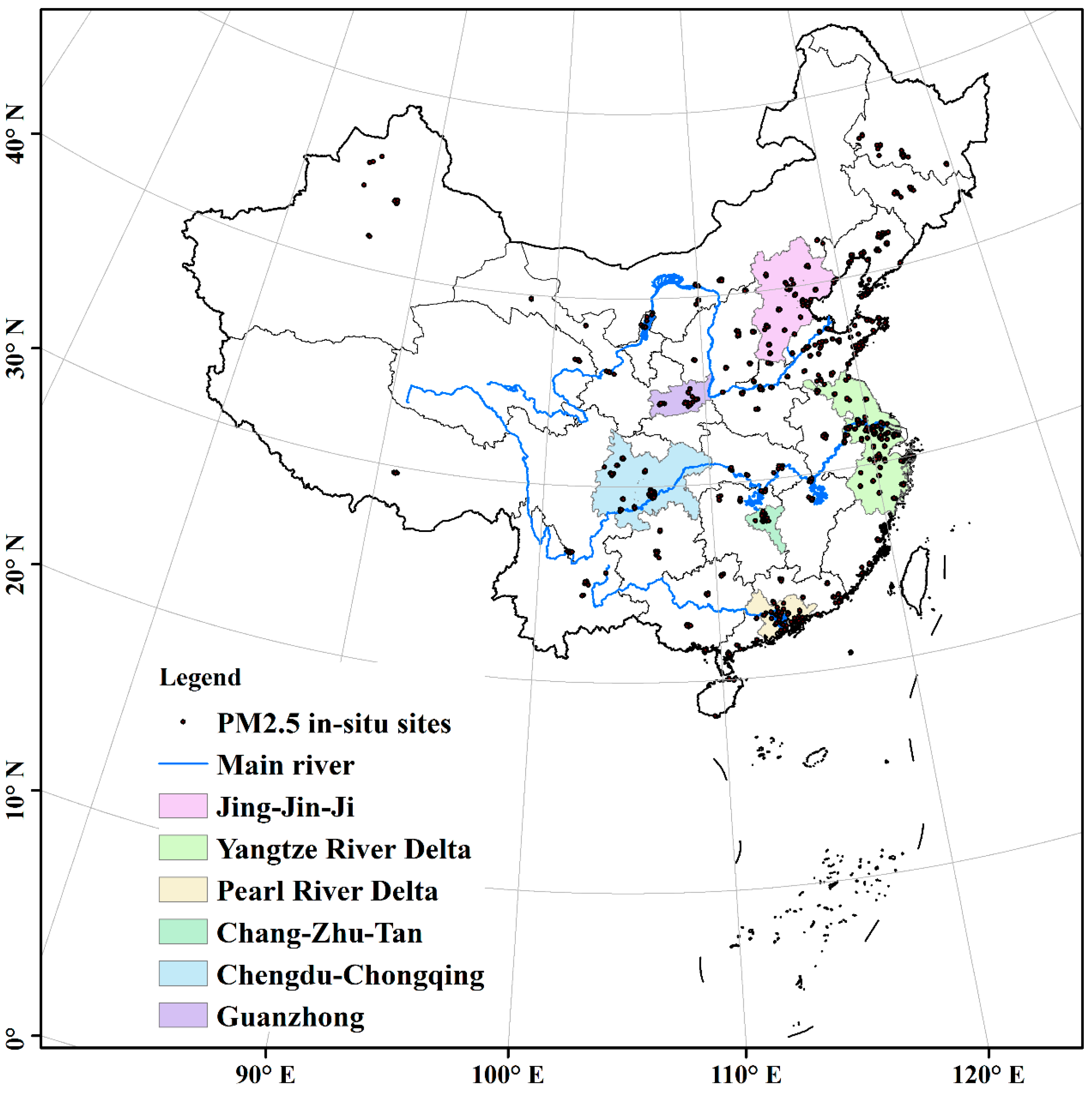
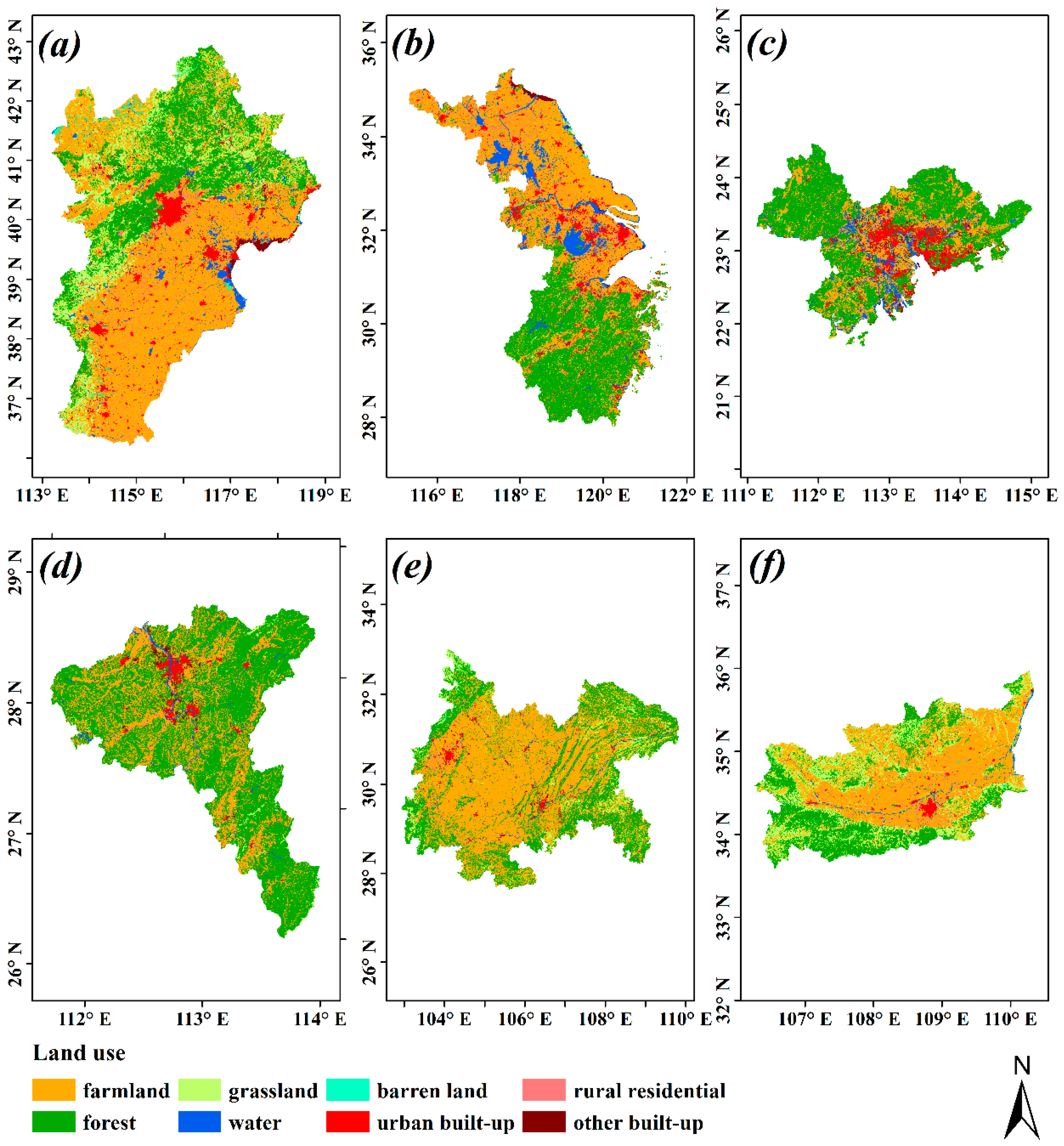



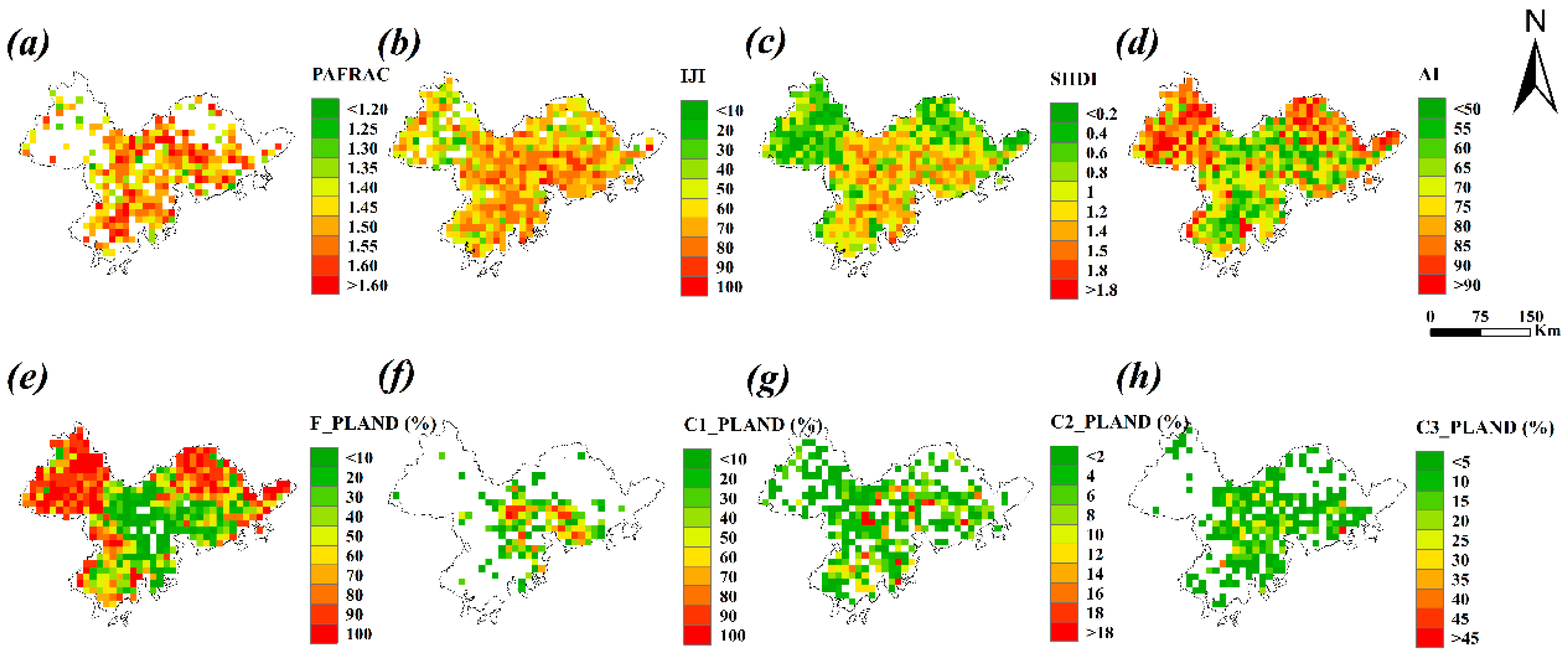
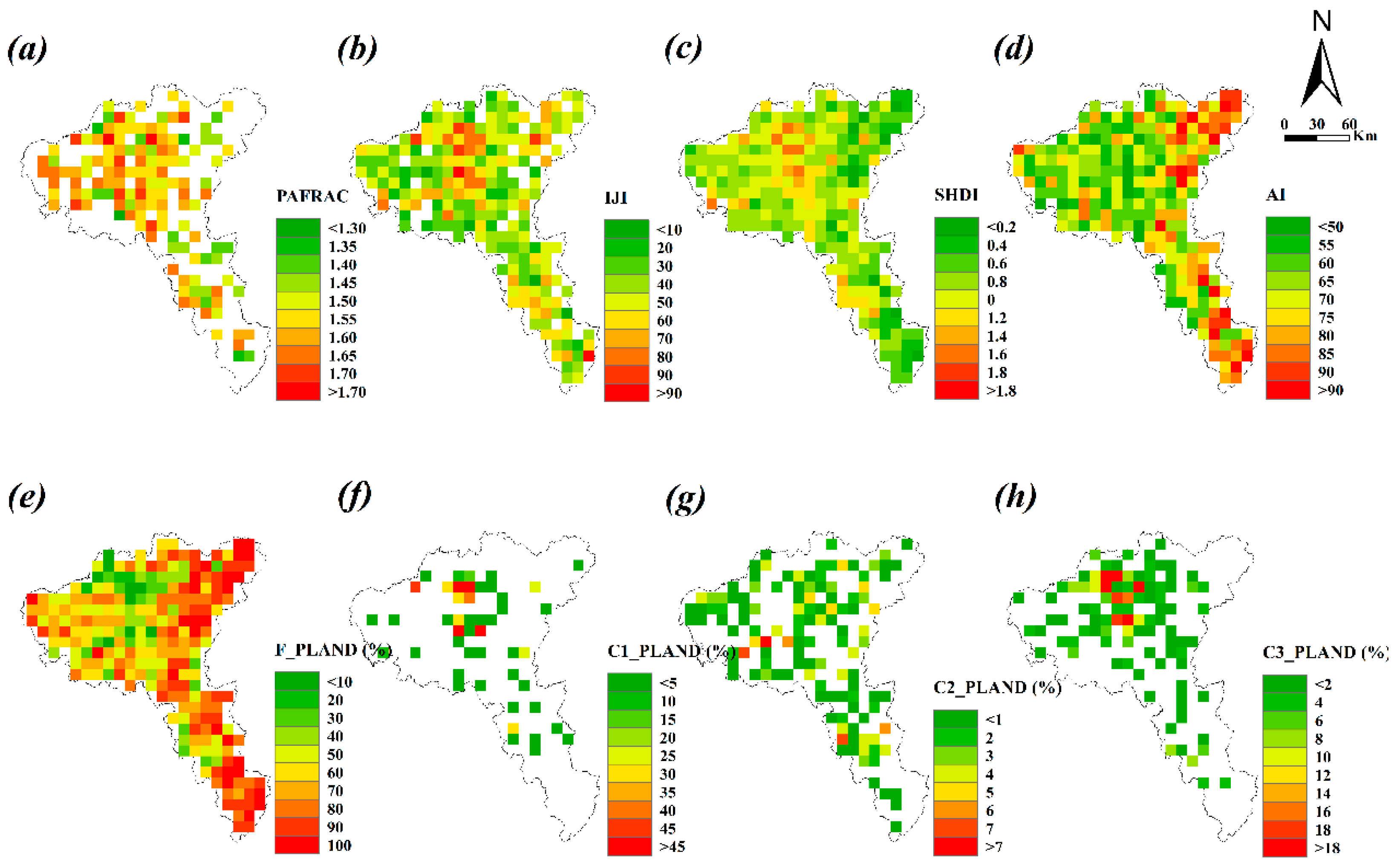
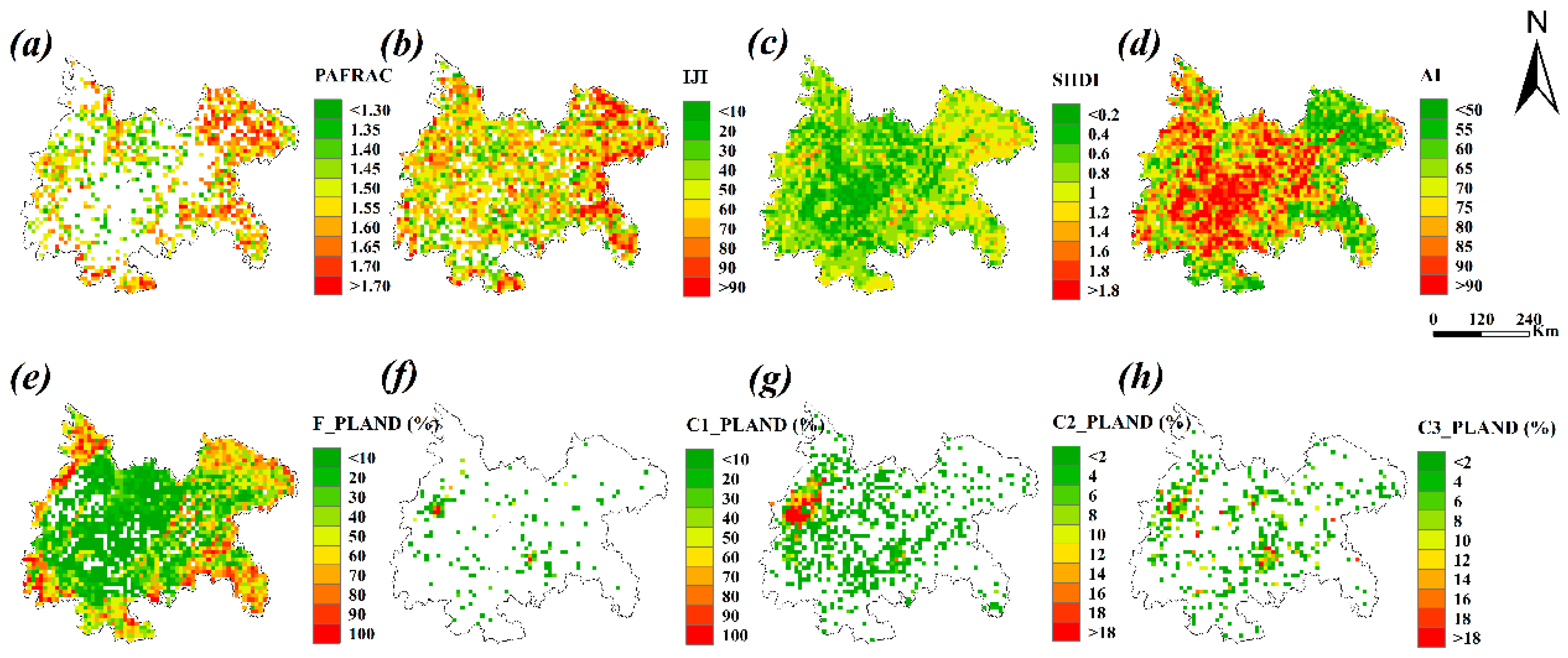
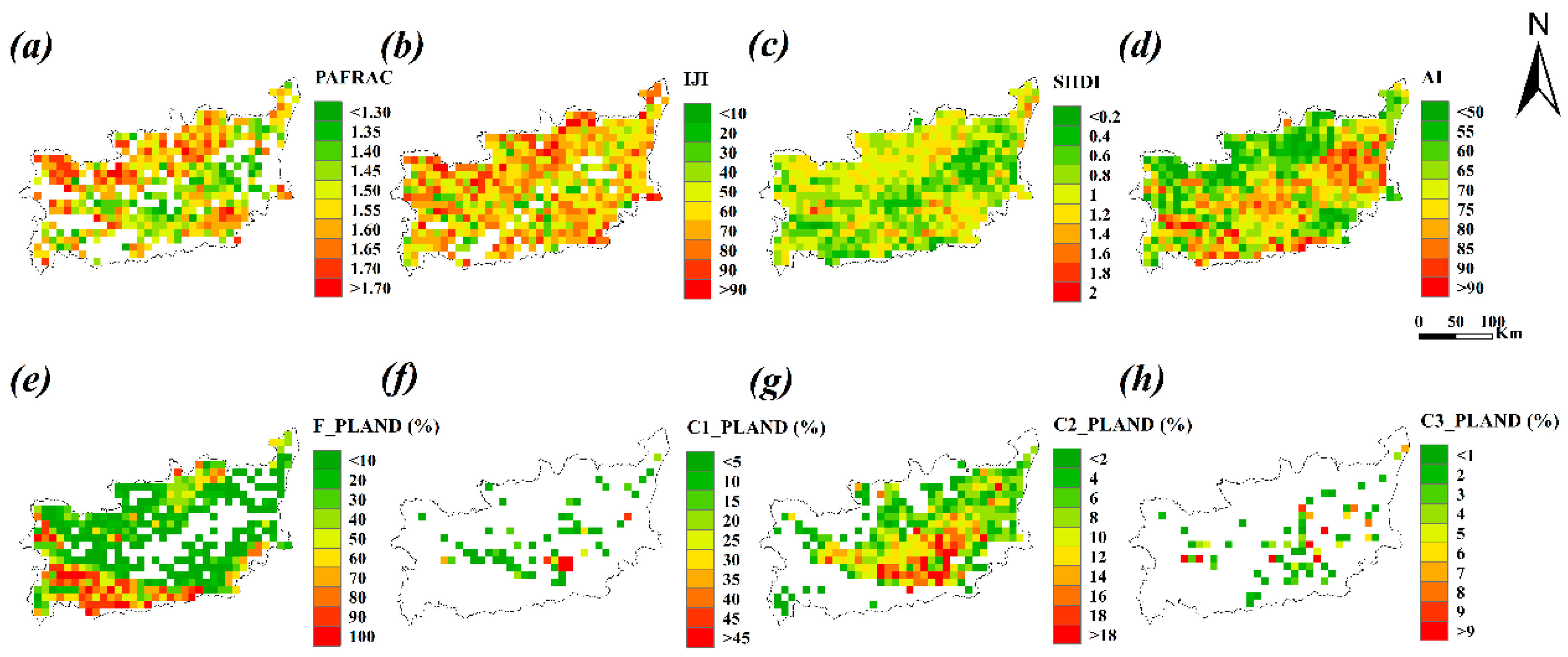
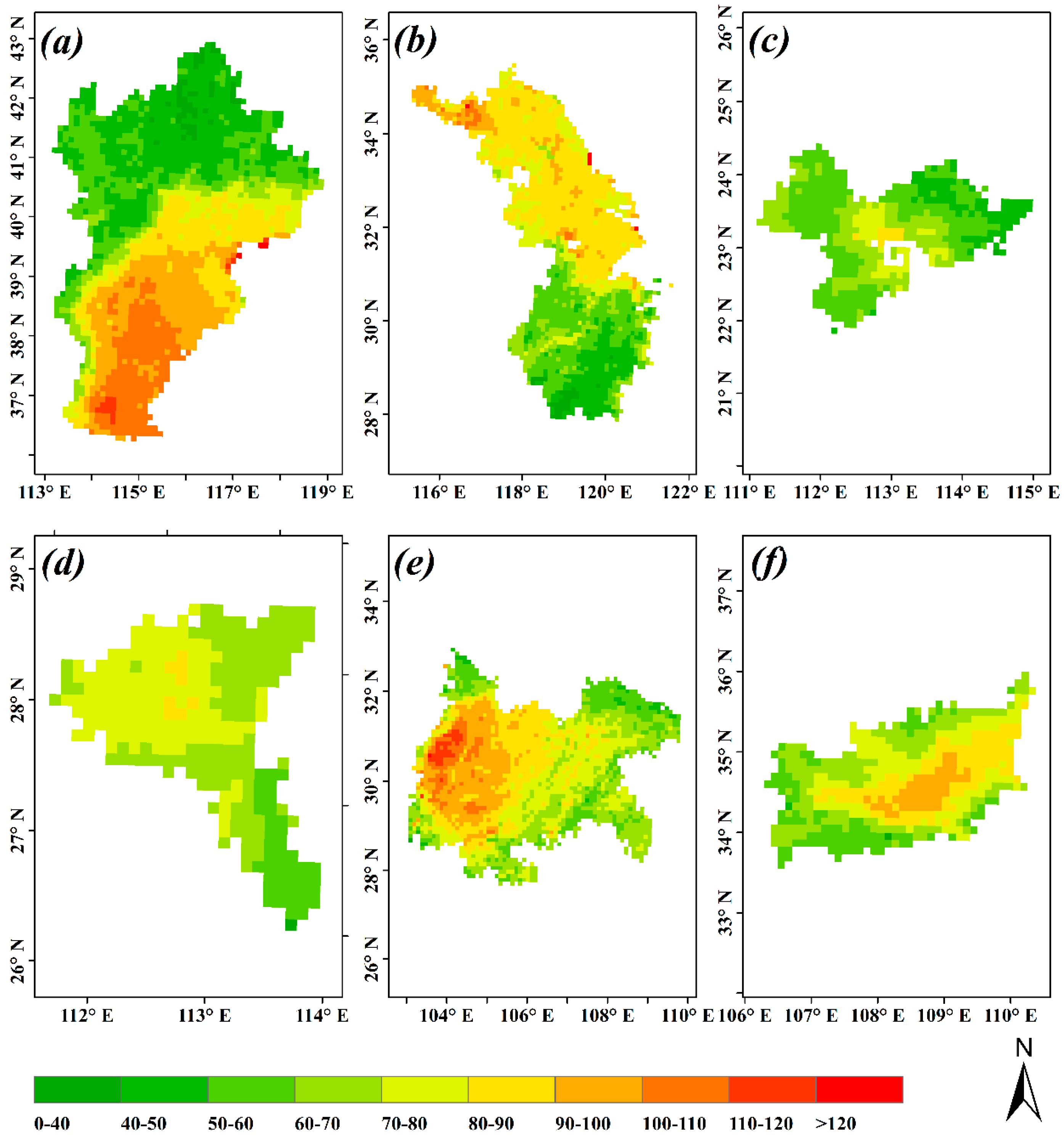
| Region (In-Situ Sites) | Buffer (m) | PAFRAC | IJI | SHDI | AI | F_PLAND | C1_PLAND | C2_PLAND | C3_PLAND |
|---|---|---|---|---|---|---|---|---|---|
| Jing-Jin-JI (80 sites) | 500 | −0.031 | −0.158 | −0.274 * | 0.273 * | −0.166 | 0.224 * | 0.017 | 0.010 |
| 1000 | −0.176 | −0.251 * | −0.270 * | 0.261 * | −0.18 | 0.244 * | −0.039 | 0.039 | |
| 3000 | −0.336 ** | −0.344 ** | −0.351 ** | 0.0390 ** | −0.215 | 0.297 ** | −0.049 | −0.111 | |
| 4000 | −0.279 * | −0.167 | −0.348 ** | 0.403 ** | −0.267 * | 0.320 ** | −0.028 | −0.095 | |
| 5000 | −0.100 | −0.098 | −0.311 ** | 0.378 ** | −0.308 ** | 0.328 ** | −0.002 | −0.080 | |
| Yangtze River Delta (162 sites) | 500 | −0.001 | −0.053 | −0.07 | 0.054 | −0.114 | 0.115 | −0.066 | −0.017 |
| 1000 | −0.049 | −0.074 | −0.121 | 0.05 | −0.160 * | 0.126 | −0.079 | 0.005 | |
| 3000 | 0.030 | −0.019 | −0.04 | −0.023 | −0.117 | 0.054 | −0.021 | −0.08 | |
| 4000 | 0.036 | −0.037 | −0.012 | −0.04 | −0.097 | −0.001 | 0.073 | −0.108 | |
| 5000 | 0.082 | −0.071 | −0.014 | −0.05 | −0.093 | −0.032 | 0.118 | −0.079 | |
| Pearl River Delta (55 sites) | 500 | −0.031 | −0.011 | −0.139 | 0.048 | −0.147 | 0.160 | −0.192 | −0.029 |
| 1000 | −0.112 | −0.206 | −0.178 | 0.095 | −0.290* | 0.206 | −0.211 | −0.064 | |
| 3000 | −0.220 | −0.115 | −0.219 | 0.229 | −0.421 ** | 0.376 ** | −0.223 | −0.165 | |
| 4000 | 0.015 | −0.093 | −0.245 | 0.216 | −0.462 ** | 0.423 ** | −0.204 | −0.212 | |
| 5000 | −0.149 | −0.300 * | −0.237 | 0.193 | −0.479 ** | 0.434 ** | −0.213 | −0.25 | |
| Chang-Zhu-Tan (24 sites) | 500 | −0.112 | 0.087 | 0.044 | 0.088 | −0.023 | 0.064 | −0.245 | 0.006 |
| 1000 | 0.038 | 0.144 | 0.067 | 0.029 | −0.123 | 0.049 | −0.212 | 0.015 | |
| 3000 | −0.151 | −0.026 | −0.004 | −0.105 | −0.140 | 0.024 | −0.120 | −0.083 | |
| 4000 | 0.201 | −0.131 | −0.148 | −0.027 | −0.127 | 0.074 | −0.167 | −0.151 | |
| 5000 | 0.013 | −0.124 | −0.173 | 0.012 | −0.182* | 0.156* | −0.316 | −0.225 | |
| Chengdu-Chongqing (53 sites) | 500 | −0.001 | 0.182 | −0.026 | 0.122 | −0.064 | 0.051 | 0.068 | −0.164 |
| 1000 | 0.178 | 0.178 | 0.208 | −0.131 | −0.053 | −0.017 | 0.184 | −0.137 | |
| 3000 | 0.091 | 0.180 | 0.202 | −0.144 | −0.272 * | 0.006 | 0.129 | −0.165 | |
| 4000 | 0.139 | 0.106 | 0.202 | −0.252 | −0.299 * | −0.025 | 0.027 | −0.12 | |
| 5000 | 0.139 | 0.106 | 0.202 | −0.252 | −0.299 * | −0.025 | 0.027 | −0.12 | |
| Guanzhong (33 sites) | 500 | 0.050 | 0.076 | 0.145 | −0.024 | −0.061 | −0.110 | 0.095 | −0.115 |
| 1000 | 0.098 | 0.034 | 0.259 | −0.154 | 0.048 | −0.170 | 0.034 | −0.105 | |
| 3000 | 0.215 | 0.014 | 0.199 | −0.216 | −0.106 | −0.230 | 0.075 | 0.015 | |
| 4000 | 0.093 | −0.009 | 0.168 | −0.193 | −0.246 * | −0.218 | 0.080 | −0.036 | |
| 5000 | 0.052 | −0.141 | 0.122 | −0.180 | −0.262 * | −0.226 * | 0.066 | −0.08 |
| Region (Pixels) | PAFRAC | IJI | SHDI | AI | F_PLAND | C1_PLAND | C2_PLAND | C3_PLAND |
|---|---|---|---|---|---|---|---|---|
| Jing-Jin-Ji (2024 pixels) | −0.174 ** | −0.335 ** | −0.262 ** | 0.220 ** | −0.642 ** | 0.188 ** | 0.613 ** | 0.132 ** |
| Yangtze River Delta (2068 pixels) | 0.218 ** | 0.068 ** | 0.205 ** | −0.081 ** | −0.807 ** | 0.235 ** | 0.555 ** | 0.031 |
| Pearl River Delta (546 pixels) | 0.413 ** | 0.413 ** | 0.442 ** | 0.044 | −0.386 ** | 0.486 ** | 0.204 ** | 0.295 ** |
| Chang-Zhu-Tan (291 pixels) | 0.347 ** | 0.217 ** | 0.466 ** | −0.05 | −0.283 ** | 0.328 ** | 0.190 ** | 0.323 ** |
| Chengdu-Chongqing (2253 pixels) | −0.065 ** | 0.026 | −0.175 ** | 0.376 ** | −0.567 ** | 0.160 ** | 0.412 ** | 0.197 ** |
| Guanzhong (538 pixels) | 0.228 ** | 0.111 * | 0.145 ** | 0.419 ** | −0.530 ** | 0.227 ** | 0.700 ** | 0.216 ** |
| Region (Pixels) | PAFRAC | IJI | SHDI | AI | F_PLAND | C1_PLAND | C2_PLAND | C3_PLAND |
|---|---|---|---|---|---|---|---|---|
| Jing-Jin-Ji | −0.124 | 0.206 | −0.348 ** | 0.471 ** | −0.438 ** | 0.485 ** | 0.284 | 0.433 ** |
| Yangtze River Delta | −0.189 | −0.197 * | −0.391 ** | 0.332 ** | −0.432 ** | 0.341 ** | 0.295 ** | −0.196 |
| Pearl River Delta | 0.227 | −0.166 | −0.296 * | 0.184 | −0.549 ** | 0.503 ** | −0.266 | 0.010 |
| Chang-Zhu-Tan | −0.090 | 0.585 ** | 0.394 | 0.027 | −0.765 ** | 0.079 | 0.219 | 0.172 |
| Chengdu-Chongqing | −0.283 | 0.070 | −0.322 * | 0.317 * | −0.402 * | 0.446 ** | −0.129 | −0.287 * |
| Guanzhong | −0.408 * | 0.029 | −0.239 | 0.290 | −0.568 ** | 0.562 ** | 0.045 | −0.352 |
© 2017 by the authors. Licensee MDPI, Basel, Switzerland. This article is an open access article distributed under the terms and conditions of the Creative Commons Attribution (CC BY) license (http://creativecommons.org/licenses/by/4.0/).
Share and Cite
Feng, H.; Zou, B.; Tang, Y. Scale- and Region-Dependence in Landscape-PM2.5 Correlation: Implications for Urban Planning. Remote Sens. 2017, 9, 918. https://doi.org/10.3390/rs9090918
Feng H, Zou B, Tang Y. Scale- and Region-Dependence in Landscape-PM2.5 Correlation: Implications for Urban Planning. Remote Sensing. 2017; 9(9):918. https://doi.org/10.3390/rs9090918
Chicago/Turabian StyleFeng, Huihui, Bin Zou, and Yumeng Tang. 2017. "Scale- and Region-Dependence in Landscape-PM2.5 Correlation: Implications for Urban Planning" Remote Sensing 9, no. 9: 918. https://doi.org/10.3390/rs9090918
APA StyleFeng, H., Zou, B., & Tang, Y. (2017). Scale- and Region-Dependence in Landscape-PM2.5 Correlation: Implications for Urban Planning. Remote Sensing, 9(9), 918. https://doi.org/10.3390/rs9090918



